What is Systemsecuritys.com?
Systemsecuritys.com is one of the sites promoting the McAfee – Your PC is infected with 5 viruses scam. The scam masquerades as a McAfee system scan, displays fake scan results and virus alerts claiming that a computer is infected with five viruses. Scammers use fake virus alerts to trick users into downloading or purchasing software they don’t need.
Usually, users end up on Systemsecuritys.com and similar scams by going to a misspelled URL or, clicking on a fake link from push notifications and spam emails. In addition, they can be redirected to this scam by malicious advertisements (malvertising) and Adware. Adware can be installed unknowingly when visiting malware-infested websites or downloading pirated versions of software.
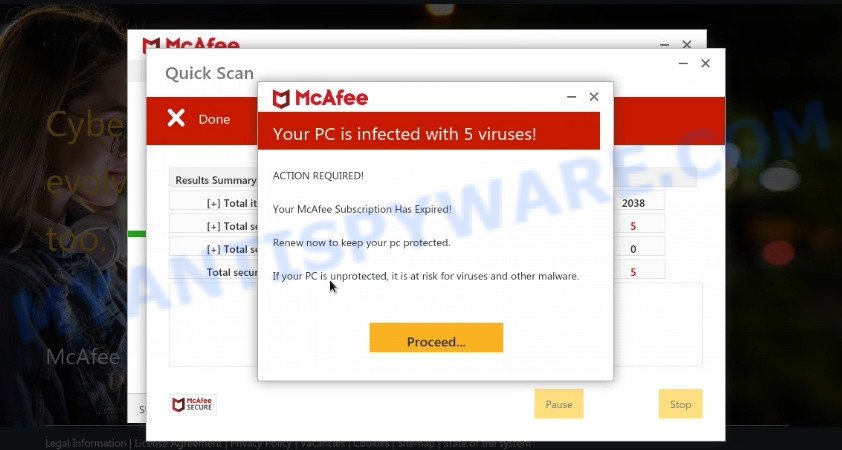
Systemsecuritys.com POP-UPS are a SCAM
QUICK LINKS
Typically, scam sites first check the user’s IP address to determine their geolocation. Scammers, having determined the user’s location, can use various scam schemes, change the page language or redirect the user to other malicious and scam sites. During the research, Systemsecuritys.com showed a fake message that the computer is infected with 5 viruses and other security threats. It instructs users to click “Proceed..”/”Renew License” to remove the found malware.
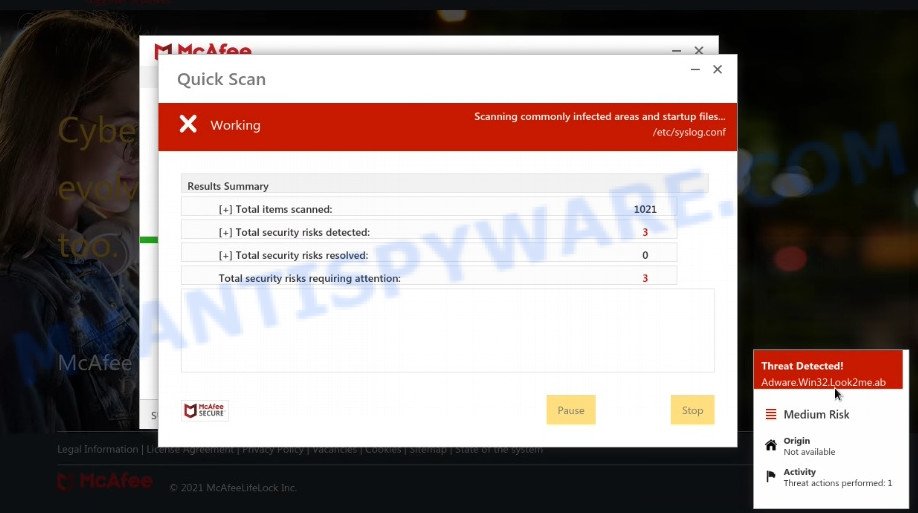
Systemsecuritys.com runs a fake system scan
As we reported above, scammers use such tactics to trick victims into installing untrustworthy and unreliable software, among which may be fake antivirus software, spyware, trojans, browser hijackers, adware and other malicious software; this is described in more detail in this article.
Systemsecuritys.com displays a show notifications pop-up that attempts to get users to click the ‘Allow’ button to allow to its notifications. These notifications are advertisements displayed in the lower right corner of the screen urges users to play online games, visit dubious web pages, install internet browser extensions & so on.

How to protect against Systemsecuritys.com scam
To avoid becoming a victim of scammers, it is important to always keep in mind:
- There are no sites that can detect viruses and other security threats.
- Never install/purchase software promoted by suspicious sites, as it can be useless, and besides, it can be dangerous for you and your computer.
- Close Systemsecuritys.com as soon as it appears on your computer screen. Scammers can prevent you from closing it in various ways. In such cases, close your browser using Task Manager or restart your computer. If the next time you launch the browser, it prompts you to restore the previous session, abandon it, otherwise this scam will reopen on your screen.
- Use an ad blocker when browsing the internet. It can block known scam sites and protect you from scammers.
Threat Summary
| Name | Systemsecuritys.com |
| Type | scam, phishing, fake virus alerts |
| Fake claims | Your PC is infected with 5 viruses, Your McAfee subscription has expired |
| Symptoms |
|
| Removal | Systemsecuritys.com removal guide |
Your McAfee Subscription Has Expired, McAfee SECURITY ALERT, McAfee – Your PC is infected with 5 viruses are other scams designed to trick visitors into installing untrustworthy software or calling fake tech support. Some of these scams are positioned as legitimate McAfee pages, but in fact have nothing to do with McAfee. The scam sites should never be trusted, they should be closed as soon as they appear on the screen.
The Systemsecuritys.com pop-ups are caused by malicious advertisements on websites you visit, browser notifications or Adware. Browser (push) notifications are originally developed to alert the user of recently published news. Scammers use push notifications to bypass pop up blockers and display lots of unwanted ads. These ads are used to promote questionable internet browser extensions, free gifts scams, adware software bundles, and adult webpages.
Adware is form of malware that shows unwanted ads on a computer, redirects search results to scam websites and collects personal info for marketing purposes. Adware can show banner ads, full-screen advertisements, pop ups, videos, push notifications or other varieties of online ads. Adware can attack your device’s web-browsers such as Microsoft Internet Explorer, Chrome, MS Edge and Firefox. Maybe you approve the idea that the ads or popups is just a small problem. But these intrusive advertisements eat system resources and slow down your computer performance.
How does Adware get on your personal computer
Adware software can be spread with the help of trojan horses and other forms of malicious software, but most often, adware is bundled with some free applications. Many creators of free software include bundled applications in their setup file. Sometimes it is possible to avoid the setup of any adware: carefully read the Terms of Use and the Software license, select only Manual, Custom or Advanced installation mode, disable all checkboxes before clicking Install or Next button while installing new freeware.
Remove Systemsecuritys.com notifications from web-browsers
If you’re getting browser notifications from the Systemsecuritys.com or another scam site, you’ll have previously pressed the ‘Allow’ button. Below we’ll teach you how to turn them off.
Google Chrome:
- Click the Menu button (three dots) on the top-right corner of the screen
- When the drop-down menu appears, click on ‘Settings’. Scroll to the bottom of the page and click on ‘Advanced’.
- In the ‘Privacy and Security’ section, click on ‘Site settings’.
- Go to Notifications settings.
- Click ‘three dots’ button on the right hand side of Systemsecuritys.com URL or other questionable URL and click ‘Remove’.
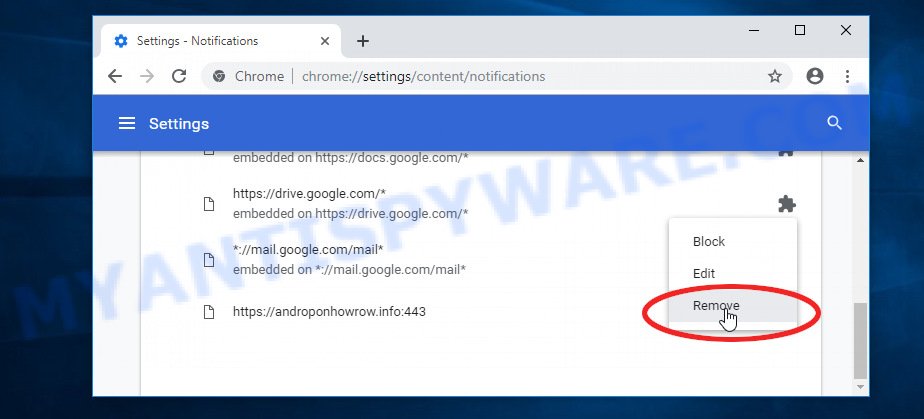
Android:
- Tap ‘Settings’.
- Tap ‘Notifications’.
- Find and tap the web browser that displays Systemsecuritys.com push notifications advertisements.
- Find Systemsecuritys.com in the list and disable it.
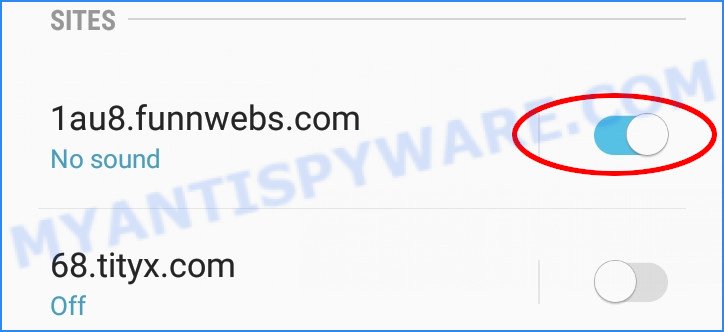
Mozilla Firefox:
- In the right upper corner, click on the three horizontal stripes to expand the Main menu.
- In the drop-down menu select ‘Options’. In the left side select ‘Privacy & Security’.
- Scroll down to ‘Permissions’ and then to ‘Settings’ next to ‘Notifications’.
- Find sites you down’t want to see notifications from (for example, Systemsecuritys.com), click on drop-down menu next to each and select ‘Block’.
- Click ‘Save Changes’ button.
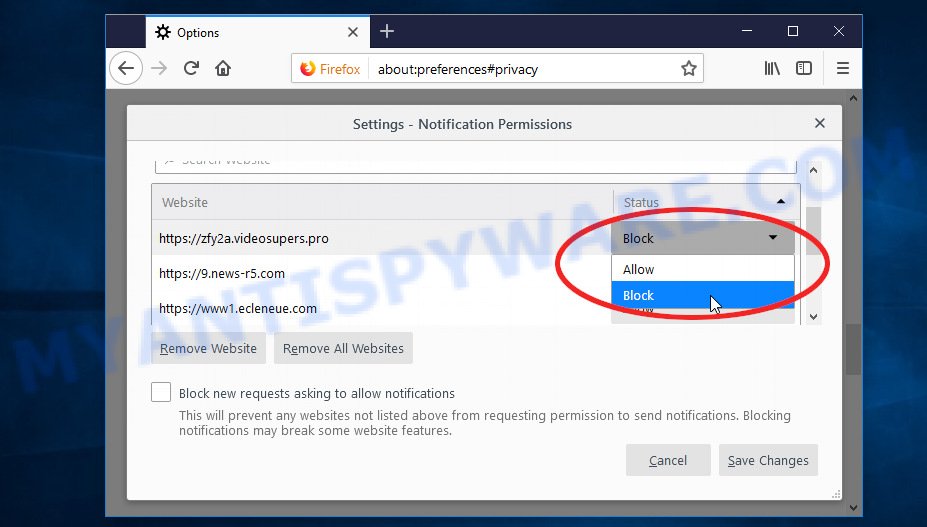
Edge:
- Click the More button (it looks like three dots) in the top right corner of the browser.
- Click ‘Settings’. Click ‘Advanced’ on the left side of the window.
- In the ‘Website permissions’ section click ‘Manage permissions’.
- Disable the on switch for the Systemsecuritys.com domain.
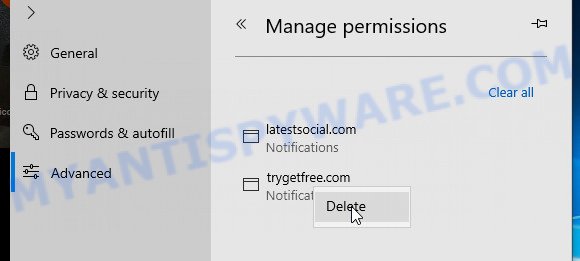
Internet Explorer:
- In the top right hand corner of the screen, click on the menu button (gear icon).
- Select ‘Internet options’.
- Click on the ‘Privacy’ tab and select ‘Settings’ in the pop-up blockers section.
- Select the Systemsecuritys.com and other questionable URLs under and remove them one by one by clicking the ‘Remove’ button.
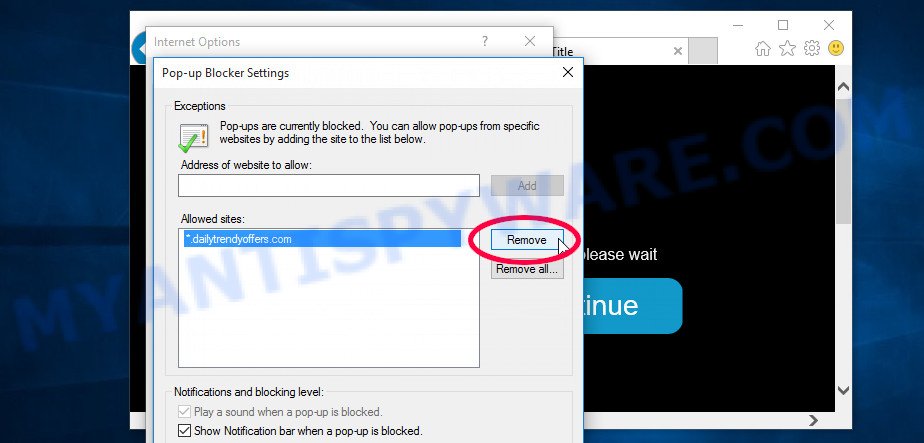
Safari:
- On the top menu select ‘Safari’, then ‘Preferences’.
- Select the ‘Websites’ tab and then select ‘Notifications’ section on the left panel.
- Find the Systemsecuritys.com URL and select it, click the ‘Deny’ button.
How to remove Systemsecuritys.com pop-up scam (Adware removal guide)
Even if you have the up-to-date classic antivirus installed, and you have checked your computer for malware and removed anything found, you need to do the guidance below. The Systemsecuritys.com scam removal is not simple as installing another antivirus. Classic antivirus software are not designed to run together and will conflict with each other, or possibly crash MS Windows. Instead we suggest complete the manual steps below after that run Zemana AntiMalware, MalwareBytes AntiMalware or HitmanPro, which are free software dedicated to detect and remove adware that causes Systemsecuritys.com pop-up in your browser. Run these tools to ensure the adware is removed.
To remove Systemsecuritys.com, perform the steps below:
- Manual Systemsecuritys.com pop up removal
- Automatic Removal of Systemsecuritys.com scam
- Stop Systemsecuritys.com scam
Manual Systemsecuritys.com pop up removal
First of all, try to remove Systemsecuritys.com popup scam manually; to do this, follow the steps below. Of course, manual adware software removal requires more time and may not be suitable for those who are poorly versed in computer settings. In this case, we recommend that you scroll down to the section that describes how to remove scam pop-ups using free adware removal tools.
Remove potentially unwanted apps through the Microsoft Windows Control Panel
Check out the MS Windows Control Panel (Programs and Features section) to see all installed software. We suggest to click on the “Date Installed” in order to sort the list of apps by the date you installed them. If you see any unknown and dubious programs, they are the ones you need to uninstall.
Make sure you have closed all browsers and other apps. Press CTRL, ALT, DEL keys together to open the Windows Task Manager.

Click on the “Processes” tab, look for something suspicious that is the adware software that causes multiple unwanted pop ups then right-click it and select “End Task” or “End Process” option. In most cases, malicious software masks itself to avoid detection by imitating legitimate Windows processes. A process is particularly suspicious: it’s taking up a lot of memory (despite the fact that you closed all of your applications), its name is not familiar to you (if you are in doubt, you can always check the program by doing a search for its name in Google, Yahoo or Bing).
Next, remove any unknown and suspicious apps from your Control panel.
Windows 10, 8.1, 8
Now, click the Windows button, type “Control panel” in search and press Enter. Choose “Programs and Features”, then “Uninstall a program”.
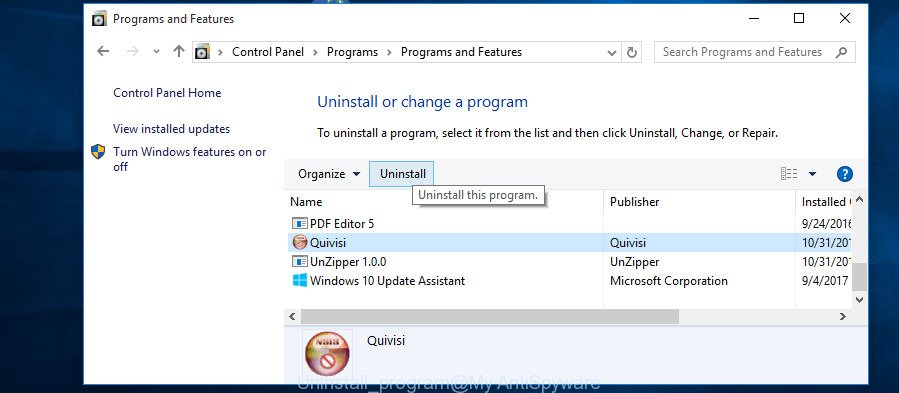
Look around the entire list of apps installed on your PC. Most probably, one of them is the adware software that causes multiple annoying pop-ups. Select the questionable program or the program that name is not familiar to you and delete it.
Windows Vista, 7
From the “Start” menu in MS Windows, select “Control Panel”. Under the “Programs” icon, choose “Uninstall a program”.

Select the dubious or any unknown programs, then click “Uninstall/Change” button to uninstall this unwanted program from your PC.
Windows XP
Click the “Start” button, select “Control Panel” option. Click on “Add/Remove Programs”.
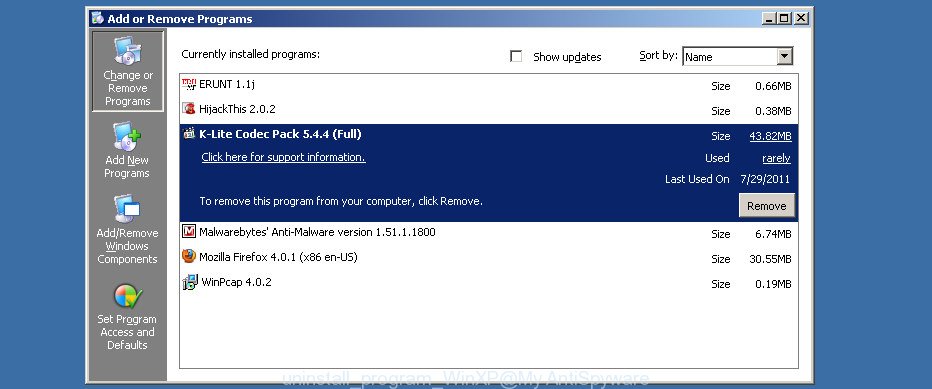
Choose an unwanted application, then click “Change/Remove” button. Follow the prompts.
Remove Systemsecuritys.com pop ups from IE
If you find that Internet Explorer web-browser settings such as homepage, default search engine and newtab had been replaced by adware software that causes Systemsecuritys.com scam in your browser, then you may return your settings, via the reset web-browser procedure.
First, launch the Internet Explorer. Next, click the button in the form of gear (![]() ). It will show the Tools drop-down menu, click the “Internet Options” such as the one below.
). It will show the Tools drop-down menu, click the “Internet Options” such as the one below.

In the “Internet Options” window click on the Advanced tab, then click the Reset button. The Internet Explorer will show the “Reset Internet Explorer settings” window as displayed on the screen below. Select the “Delete personal settings” check box, then click “Reset” button.

You will now need to restart your PC for the changes to take effect.
Remove Systemsecuritys.com scam from Chrome
The adware can alter your Google Chrome settings without your knowledge. You may see an undesired web site as your search provider or startpage, additional add-ons and toolbars. Reset Google Chrome web browser will help you to remove Systemsecuritys.com pop ups and reset the unwanted changes caused by adware. When using the reset feature, your personal information such as passwords, bookmarks, browsing history and web form auto-fill data will be saved.
First start the Chrome. Next, press the button in the form of three horizontal dots (![]() ).
).
It will open the Google Chrome menu. Select More Tools, then click Extensions. Carefully browse through the list of installed extensions. If the list has the addon signed with “Installed by enterprise policy” or “Installed by your administrator”, then complete the following guide: Remove Chrome extensions installed by enterprise policy.
Open the Google Chrome menu once again. Further, click the option named “Settings”.

The web browser will show the settings screen. Another method to show the Google Chrome’s settings – type chrome://settings in the web browser adress bar and press Enter
Scroll down to the bottom of the page and click the “Advanced” link. Now scroll down until the “Reset” section is visible, like below and press the “Reset settings to their original defaults” button.

The Google Chrome will display the confirmation prompt like the one below.

You need to confirm your action, click the “Reset” button. The web-browser will run the task of cleaning. Once it is complete, the web-browser’s settings including startpage, new tab and default search engine back to the values that have been when the Chrome was first installed on your PC system.
Delete Systemsecuritys.com from Firefox by resetting web browser settings
If the Mozilla Firefox web-browser program is hijacked, then resetting its settings can help. The Reset feature is available on all modern version of Firefox. A reset can fix many issues by restoring Mozilla Firefox settings such as start page, default search engine and new tab to their default state. However, your saved passwords and bookmarks will not be changed or cleared.
Click the Menu button (looks like three horizontal lines), and press the blue Help icon located at the bottom of the drop down menu such as the one below.

A small menu will appear, click the “Troubleshooting Information”. On this page, click “Refresh Firefox” button as displayed on the image below.

Follow the onscreen procedure to restore your Firefox web-browser settings to their default values.
Automatic Removal of Systemsecuritys.com scam
The simplest way to remove Systemsecuritys.com scam is to run an anti-malware application capable of detecting adware. We suggest try Zemana AntiMalware or another free malware remover which listed below. It has excellent detection rate when it comes to adware, hijackers and other potentially unwanted software.
Remove Systemsecuritys.com pop up scam with Zemana
You can download and use the Zemana Anti-Malware for free. This anti-malware utility will scan all the Microsoft Windows registry keys and files in your computer along with the system settings and web browser extensions. If it finds any malware, adware software or harmful extension that is responsible for Systemsecuritys.com scam then the Zemana AntiMalware will remove them from your computer completely.

- Zemana AntiMalware can be downloaded from the following link. Save it directly to your Microsoft Windows Desktop.
Zemana AntiMalware
164813 downloads
Author: Zemana Ltd
Category: Security tools
Update: July 16, 2019
- Once downloading is done, close all programs and windows on your personal computer. Open a folder in which you saved it. Double-click on the icon that’s named Zemana.AntiMalware.Setup.
- Further, click Next button and follow the prompts.
- Once installation is done, click the “Scan” button to perform a system scan for the adware software that causes Systemsecuritys.com pop ups. A system scan can take anywhere from 5 to 30 minutes, depending on your PC. While the Zemana Anti-Malware utility is checking, you can see how many objects it has identified as being affected by malware.
- Once Zemana Anti-Malware has completed scanning your computer, you’ll be displayed the list of all detected threats on your computer. Next, you need to click “Next”. After that process is done, you can be prompted to reboot your personal computer.
Remove Systemsecuritys.com scam and malicious extensions with HitmanPro
All-in-all, Hitman Pro is a fantastic tool to free your PC system from any undesired apps like adware responsible for Systemsecuritys.com scam. The Hitman Pro is portable application that meaning, you do not need to install it to run it. Hitman Pro is compatible with all versions of MS Windows OS from Microsoft Windows XP to Windows 10. Both 64-bit and 32-bit systems are supported.
First, please go to the following link, then click the ‘Download’ button in order to download the latest version of HitmanPro.
When the downloading process is done, open the file location. You will see an icon like below.

Double click the HitmanPro desktop icon. When the utility is opened, you will see a screen as shown in the following example.
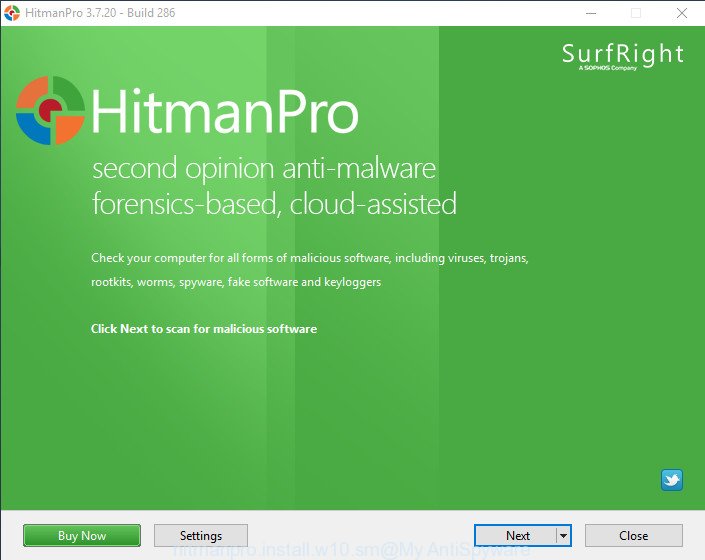
Further, press “Next” button to perform a system scan for the adware that causes Systemsecuritys.com scam. A system scan can take anywhere from 5 to 30 minutes, depending on your computer. Once the scan is done, Hitman Pro will open a list of found items as displayed in the following example.
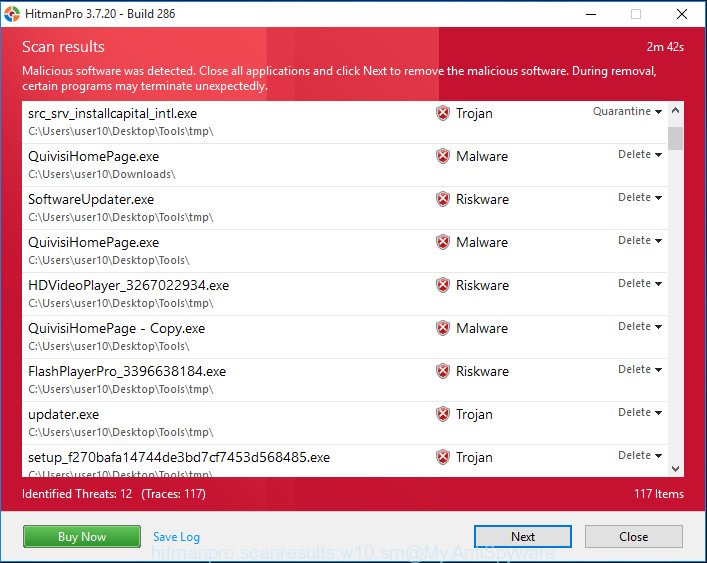
Review the scan results and then click “Next” button. It will show a prompt, click the “Activate free license” button.
How to remove Systemsecuritys.com with MalwareBytes AntiMalware
Manual Systemsecuritys.com pop up scam removal requires some computer skills. Some files and registry entries that created by the adware software can be not fully removed. We recommend that run the MalwareBytes Anti-Malware that are completely clean your PC of adware. Moreover, the free program will allow you to remove malware, potentially unwanted programs, hijackers and toolbars that your computer can be infected too.
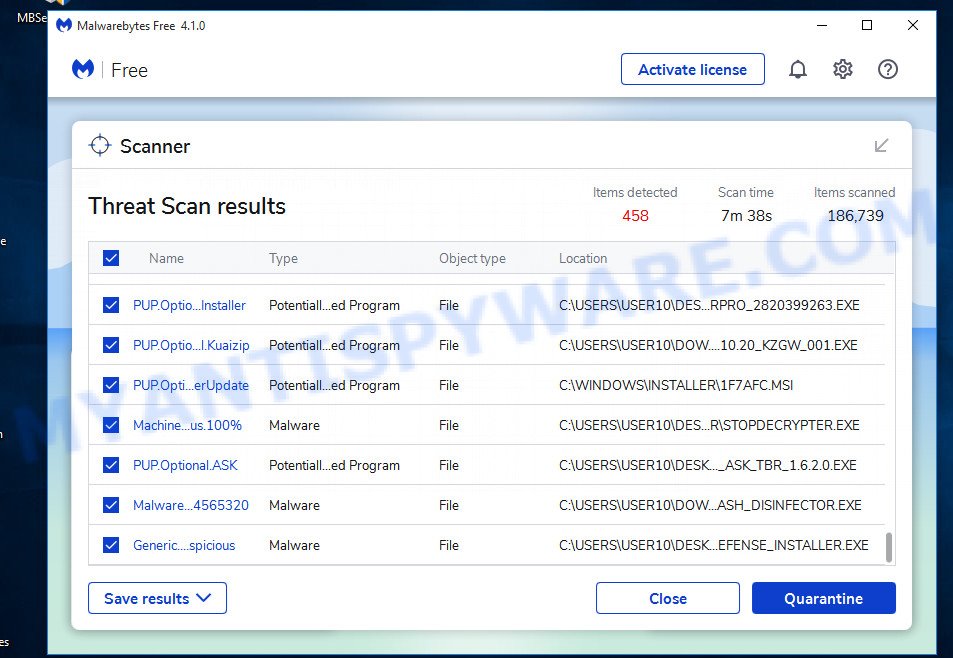
First, click the link below, then press the ‘Download’ button in order to download the latest version of MalwareBytes AntiMalware.
327070 downloads
Author: Malwarebytes
Category: Security tools
Update: April 15, 2020
When the downloading process is finished, run it and follow the prompts. Once installed, the MalwareBytes will try to update itself and when this procedure is complete, press the “Scan” button to begin checking your computer for the adware software that causes the Systemsecuritys.com pop ups. Depending on your personal computer, the scan can take anywhere from a few minutes to close to an hour. Review the scan results and then click “Quarantine” button.
The MalwareBytes AntiMalware is a free program that you can use to get rid of all detected folders, files, services, registry entries and so on. To learn more about this malware removal tool, we advise you to read and follow the few simple steps or the video guide below.
Stop Systemsecuritys.com scam
To put it simply, you need to use an ad blocking utility (AdGuard, for example). It’ll block and protect you from any scam web sites like Systemsecuritys.com, malicious ads and pop ups. To be able to do that, the ad-blocker application uses a list of filters. Each filter is a rule that describes a malicious web page, an advertising content, a banner and others. The ad-blocker program automatically uses these filters, depending on the web-pages you’re visiting.
Click the link below to download AdGuard. Save it to your Desktop.
26842 downloads
Version: 6.4
Author: © Adguard
Category: Security tools
Update: November 15, 2018
After downloading is complete, start the downloaded file. You will see the “Setup Wizard” screen as displayed in the figure below.

Follow the prompts. After the installation is finished, you will see a window as displayed in the figure below.

You can click “Skip” to close the installation application and use the default settings, or click “Get Started” button to see an quick tutorial that will allow you get to know AdGuard better.
In most cases, the default settings are enough and you do not need to change anything. Each time, when you start your personal computer, AdGuard will start automatically and stop unwanted ads, block Systemsecuritys.com, as well as other malicious or misleading web pages. For an overview of all the features of the program, or to change its settings you can simply double-click on the AdGuard icon, which can be found on your desktop.
To sum up
We suggest that you keep AdGuard (to help you stop unwanted ads and unwanted harmful webpages) and Zemana Anti-Malware (to periodically scan your PC for new malicious software, browser hijackers and adware). Make sure that you have all the Critical Updates recommended for Microsoft Windows OS. Without regular updates you WILL NOT be protected when new browser hijackers, harmful software and adware are released.
If you are still having problems while trying to delete Systemsecuritys.com pop ups from your internet browser, then ask for help here.


















